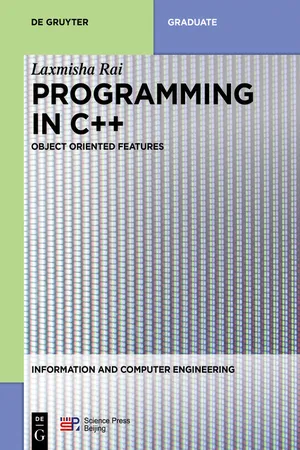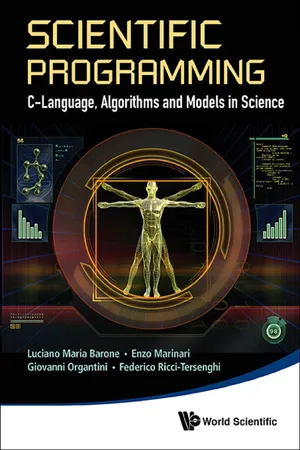Computer Science
C Plus Plus
C++ is a high-level programming language that is widely used in computer science. It is an extension of the C language and supports object-oriented programming, making it a versatile language for developing complex software applications. C++ is known for its efficiency, speed, and flexibility.
Written by Perlego with AI-assistance
Related key terms
2 Key excerpts on "C Plus Plus"
- eBook - ePub
Programming in C++
Object Oriented Features
- Laxmisha Rai(Author)
- 2019(Publication Date)
- De Gruyter(Publisher)
2 Introduction to Object-Oriented Programming and C++ Life is a series of natural and spontaneous changes. Don’t resist them – that only creates sorrow. Let reality be reality. Let things flow naturally forward in whatever way they like. ―Lao Tzu 2.1 Introduction In Chapter 1, we have studied about the basic concepts of computers and programming languages. There are many types of programming languages, such as procedural, functional, and object oriented. Our main purpose in this chapter is to understand the main features of OOP languages and the ways of compiling and running a C++ program successfully. In object-oriented programming, writing a program is easier and more convenient than many other types of programming languages. Today, an OOP language, such as C++, is popular and widely used to develop many software applications. However, the OOP is a new paradigm among programming languages. The basic concepts of an OOP language revolve around topics such as objects, classes, data abstraction, encapsulation, inheritance, polymorphism, and dynamic binding. In this chapter, we will focus on some of the basic concepts of object-oriented programming and how to write a simple C++ program. In addition, we will also present the steps to compile a program using freely available online compilers, Visual Studio, VC++ compiler, and CodeBlocks. 2.2 Object-oriented concepts Object-oriented programming has a number of advantages. It is simpler and easier to read and write programs. It can reuse the code more efficiently, and provide a robust and error-free code. In this section, we will try to understand various features of object-oriented programming languages briefly. Objects and classes In OOP, programs are written by using objects and classes. OOP concepts are different from other programming languages. All real-world objects are represented by objects. Every object has certain state and behavior. The state of the object is represented by variables and the behavior by methods - eBook - ePub
Scientific Programming: C-language, Algorithms And Models In Science
C-Language, Algorithms and Models in Science
- Luciano Maria Barone, Enzo Marinari, Giovanni Organtini, Federico Ricci Tersenghi(Authors)
- 2013(Publication Date)
- WSPC(Publisher)
C is a procedural language, not fully structured and typed. We already know what procedural means. A language is said to be structured if certain rules are obeyed when expressing the sequence of actions in the code. In Chapter 4 we discuss these rules for C in detail. In particular, structured programs do not allow to transfer the control of operations from one portion of code to another non-adjacent one by means of operations of the goto kind. C possesses a certain number of these statements allowing the execution flow to jump from one part to another. Therefore, it is not strictly structured. However, a program in C can always be rewritten without making use of these statements, resulting in a structured C program.C is a typed language. This means that all data need to be declared before they can be used in a program and this declaration should specify their type (integer, rational, string, etc.). Still, C is not considered a strongly typed language. Indeed, it is always possible to interpret a bit sequence corresponding to data of a certain type as if they belonged to another type. In C, errors due to bad programming can always be eliminated by using the methods of structured programming. However, it is not always possible to avoid the use of so-called type casting, i.e., the transformation of one type to another (Section 3.2).Nevertheless (and, in some cases, even thanks to this flexibility), C is quite adapted as a first language to learn the scientific programming methods. 2.8C compilers in their environmentThe operating system is a program that, when a computer is turned on, is loaded into its memory and immediately executed (bootstrapped in technical jargon). It takes care of the management of the computer resources (the CPU, the memory, the peripherals) and allows the programmer to interact with these by giving instructions (in the form of text, signs, sounds, etc.) without knowing the particular hardware structure of the machine or how the memory is organized15 .In theory, many different operating systems can be loaded on each CPU (not at the same time though). The most widespread ones are Microsoft® Windows® , Mac OS®
Learn about this page
Index pages curate the most relevant extracts from our library of academic textbooks. They’ve been created using an in-house natural language model (NLM), each adding context and meaning to key research topics.

